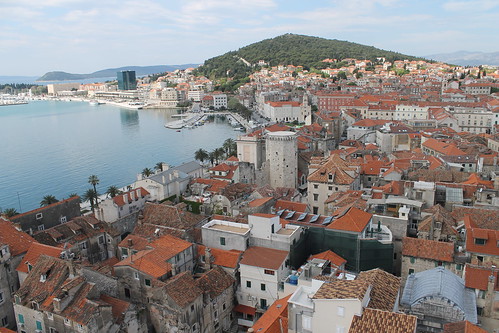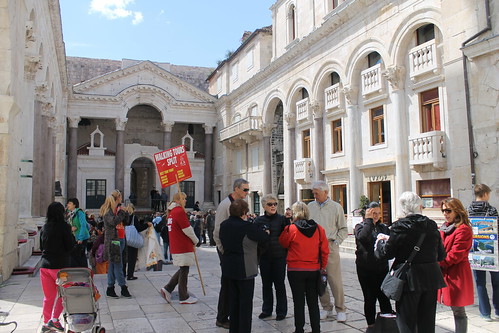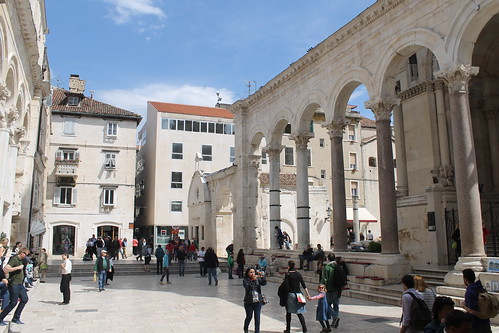Written on the ICN 522 Split – Zagreb, Croatia
Saturday, April 19, 1:40 – 7:48 pm
Another country, another train.
This afternoon, we said goodbye to Split, Croatia’s second city. From the harbor, we could see Diocletian’s Palace, the Roman ruins that had captivated our attention for three days, as well as the large harbor, which boasted ferries to Brac, Havr, and other numerous islands in the Adriatic. On a clear day, from the Marjan Hill to the west of the city, you can see three or four islands on the horizon to the south, and a hundred miles or so beyond, the eastern shore of Italy.

Split was quite amazing. The city itself is nestled in a bowl, built up around the core of the medieval town of Split, which itself was founded on Diocletian’s Palace. I recalled some of my ancient Roman history which I ingested during my high school years. Diocletian was best known for having split the Roman Empire into eastern and western halves, as well as his merciless persecution of Christians in the empire. Just a generation after him, however, Constantine reversed that trend for good. When he retired, Diocletian built his palace in Split to keep himself amused. We spent hours wandering the ancient ruins, which itself tells the very clear history of Western civilization. The original Roman ruins of the palace, whose square outlines can still be seen, have been written over many times, first by the medieval ages which made a cathedral out of the mausoleum and filled the subterranean chambers of the palace with debris. There is also a temple of Jupiter which remains preserved as is today, with a stone vaulted ceiling that is intricately carved inside, but its majesty is somewhat diminished due to all the buildings from the Renaissance period that are squished right up against it. Today, the peristyle or courtyard of the main palace is flanked by the bell tower, a decidedly mid-1800 creation and a café where visitors can take a seat on the marble stairs and enjoy a good cup of Julius Meinl coffee.


One of our chief interests in visiting Split was not simply the Roman ruins but the fact that Diocletian’s Palace was one of the shooting locations for Season 4 in Game of Thrones. Steve and I had a good time debating amongst ourselves where it was to be. Two main candidates emerged as either the bell tower or the subterranean chambers. The former is a beauty, its symmetrical stateliness drawing the eye as it soars skyward above the arches of the peristyle. We climbed it and marveled at the excellent view all around, of the karst mountains to the north and east, the green-covered Marjan Hill to the west, and spacious harbor to the south.

The latter is something we paid 40 kuna each for the privilege of investigating. It is the most intact portion of Diocletian’s Palace remaining, as it lies immediately below his palace complex and mirrors the layout above. The first level where Diocletian would have lived is completely gone, so the subterranean chambers, which were used for storage of wine and food and perhaps olive pressing, are our best guess at what his chambers looked like. We discovered a lot of worn stone pieces, moss-grown archways, and in one spot, delicate old floor mosaics which may not have been original but are definitely very aged. The chambers we thought a good likelihood for the fliming, because all was required was to turn off the electric lighting and install torches on the walls to evoke the chambers and cellars of an old medieval castle.

For the rest of our time, we lucked into a very comfortable apartment on Airbnb and enjoyed the use of the first bathtub I have encountered since we left Chicago, though I had the luxury of a bathhouse in Kyoto. Split’s weather turned wet and windy again while we were there, so we made ample use of the hot water. Finally, we left on the express train which departed twice a day for Zagreb, taking six hours in the journey.
At first, the winding and tilting of the train made it almost worse than the bus we had considered taking from Split to Zagreb. After a few hours, where I was unable to admire the scenery outside and had discovered new ways to contort my body so as to lie down on the two seats across, I woke up while we were stopped at a station, and when we commenced our journey again, I discovered that we had left behind the coast for a more straightforward or gently arcing path that allowed me to feel less nauseous and able to contemplate a book or computer screen.
There are some truly beautiful valleys here, ringed in by hills where our train is snaking through. The green space between them are strewn with woods, dark red and brown squares of worked land, orange roofs, and the darker green of pines and shrubs. It looks just remarkably pastoral and beautiful. We passed one house with a pasture of sheep fat with excess light-brown wool, not yet shaved for the spring. They looked more like large fat potatoes on four legs than anything else. We have also passed our share of small provincial towns. Their equally small dilapidated stations with unlovely names like “Blata” or “Duga Resa” flash by, the only witness to our passing an old stationmaster and a Saint Bernard guarding a house. Now, sunset is casting a more friendly, golden light on the landscape, and the shadow of our train stretches more than a hundred of meters onto the houses beside the tracks. We should arrive in Zagreb right before 8 pm, time to get into our new apartment and grab a late dinner.
Steve and I both look forward to Zagreb again. It is a very underrated city with many amenities, interesting cultural attractions, and the most delicious toasted sandwiches for just two or three dollars. We’re glad to have a chance to visit the museums that we bypassed a few weeks ago and to watch spring come into itself more fully in this city. It also doesn’t hurt that prices in Zagreb for both groceries and proper restaurants are much lower than we found in both Dubrovnik and Split. A few more weeks of wandering around this city, and then it’s onto France.
Connie
I went to a Roman ruin in Portugal, north of Lisbon, south of Fatima, and marveled at the tile work in this home we explored. They had underground troughs for hot and cold water, used to heat or cool the house and to fill the huge, multiperson bathtub! Many swastikas adorned the tile work because it was thought to bring good luck and prosperity. With our own country being so young, it continues to amaze me when I see such antiquity survive. Quite humbling.
I really love all the antiquities! Wait until we get to Lyon — there’s a large Roman ampitheatre in the city that’s still being used! It’s amazing.
https://en.wikipedia.org/wiki/Amphitheatre_of_the_Three_Gauls
19 AD!!!
I am glad you had fun time there, my friends have been nagging me for ages to go. Looks nice. But I have a question. Is it a Western country or a Balkan country? As far as I know from my travels in Macedonia, those two don’t mix together 🙂
Hey – good question. From a quick Google search, I think Croatia sounds like the most westernized of the Balkan countries. I see what you mean by the tension between Western and Balkan countries, but I have to say that was not really the impression we got in Croatia. Everyone was extraordinarily nice, and there was a very high degree of English literacy. There didn’t seem to be a cultural clash with Western Europe, though as tourists who looked like the Americans we are, I don’t think we would have felt the tension if it existed. Though Croatia won’t adopt the euro for another few years, it’s firmly in the EU, and other countries are expected to follow the model that Croatia has set. I hope you do manage to visit. It’s a great place!